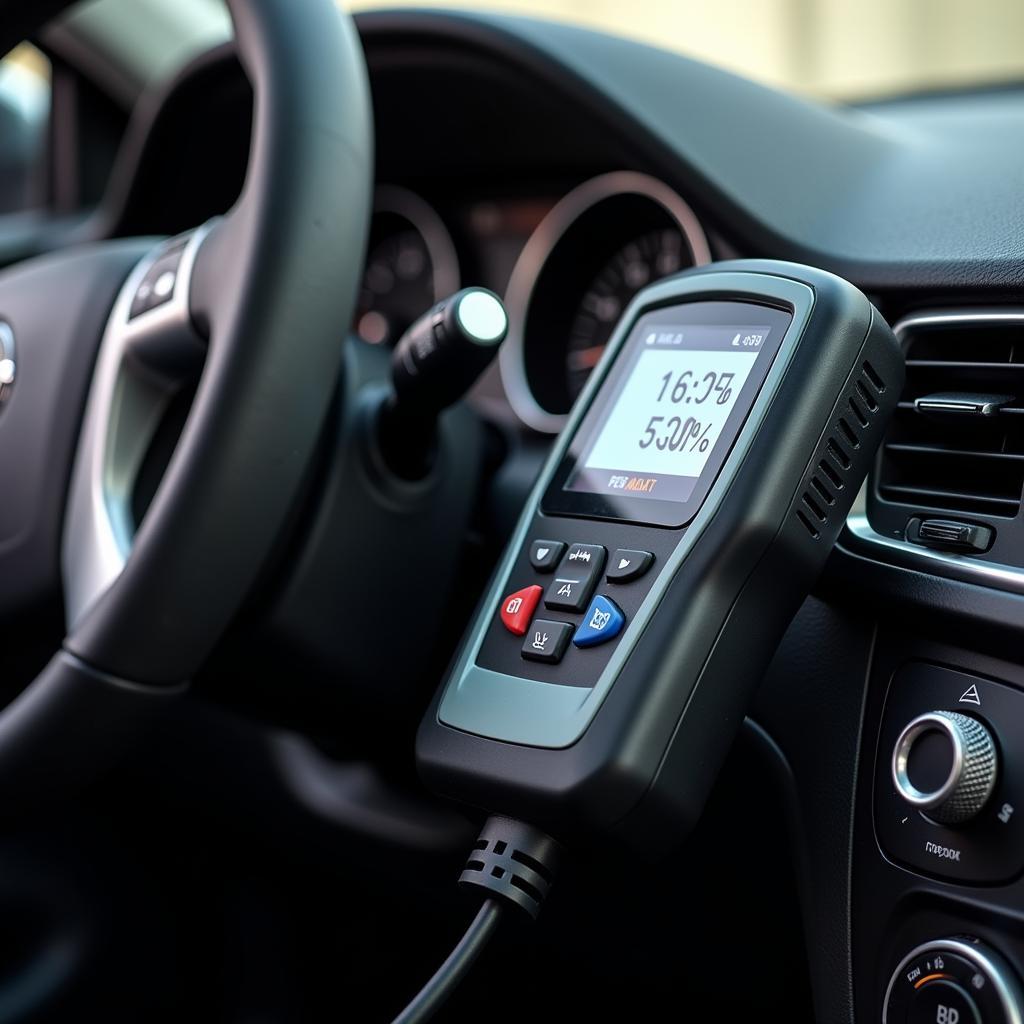A blinking check engine light can be a real mood killer, especially when you have no idea what’s wrong. Enter the OBD2 code reader – a handy device that can translate those cryptic codes into plain English. But can OBD2 code reader instructions alone really empower you to fix your car? Let’s dive in.
 OBD2 code reader connected to a car's diagnostic port
OBD2 code reader connected to a car's diagnostic port
Understanding OBD2 Code Readers and Their Instructions
OBD2, short for On-Board Diagnostics, is a standardized system in vehicles manufactured after 1996. This system monitors various components in your car and generates diagnostic trouble codes (DTCs) when something goes wrong.
An OBD2 code reader, often a handheld device, plugs into your car’s OBD2 port (usually located under the steering wheel) and reads these codes. The accompanying instructions then guide you on how to:
- Connect the reader: This usually involves locating the OBD2 port, plugging in the device, and turning the ignition on without starting the engine.
- Retrieve codes: The reader scans your car’s computer and displays any stored trouble codes.
- Interpret codes: This is where things get interesting. While some readers simply display the code, others offer brief descriptions or even direct you to potential solutions.
The Limitations of OBD2 Code Reader Instructions
While OBD2 code reader instructions can be invaluable in identifying potential car problems, they are not a magic bullet for DIY car repairs. Here’s why:
- Codes are starting points, not diagnoses: A code like “P0420” might indicate a catalytic converter issue, but it doesn’t tell you why the converter is malfunctioning. It could be a faulty oxygen sensor, a leak in the exhaust system, or something else entirely.
- Complexity of modern cars: Today’s vehicles are incredibly complex. Even with code interpretations, pinpointing the exact cause and solution requires deeper mechanical knowledge and diagnostic tools beyond a basic code reader.
- Varied instructions: Just like OBD2 readers themselves, their instructions vary greatly in detail and clarity. Some offer comprehensive guidance, while others provide barebones information.
When Can You Rely on OBD2 Code Reader Instructions?
Despite their limitations, OBD2 code readers and their instructions are excellent tools for:
- Early problem detection: Knowing a code exists before any noticeable symptoms appear allows you to address the issue proactively, potentially preventing costly repairs down the line.
- Simple fixes: For issues like a loose gas cap triggering an emissions code, the reader instructions might guide you to the solution directly.
- Informed decisions: Even if you can’t fix the problem yourself, understanding the codes empowers you to communicate effectively with a mechanic, avoiding unnecessary guesswork and potentially saving on diagnostic fees.
Beyond the Instructions: Getting the Most Out of Your OBD2 Code Reader
To truly maximize the value of your OBD2 code reader, consider these tips:
- Invest in a quality reader: A more advanced reader might offer more detailed code descriptions, live data readings, and even troubleshooting tips.
- Consult online resources: Websites and forums dedicated to your specific car model can provide valuable insights into common codes and their potential solutions.
- Don’t be afraid to seek professional help: When in doubt, always consult a qualified mechanic.
Conclusion
While OBD2 code reader instructions alone might not make you a master mechanic overnight, they are incredibly valuable for any car owner. By understanding the limitations and leveraging additional resources, you can use these devices to stay informed about your car’s health, make informed repair decisions, and potentially save time and money in the long run.
Need expert advice on choosing the right OBD2 scanner for your needs? Contact our team at WhatsApp: +1(641)206-8880, Email: [email protected]. We’re available 24/7 to assist you.

